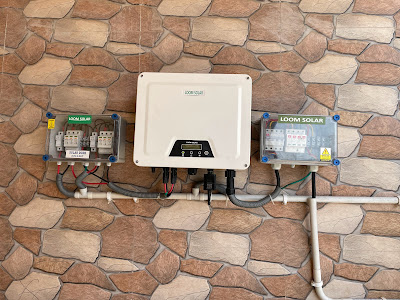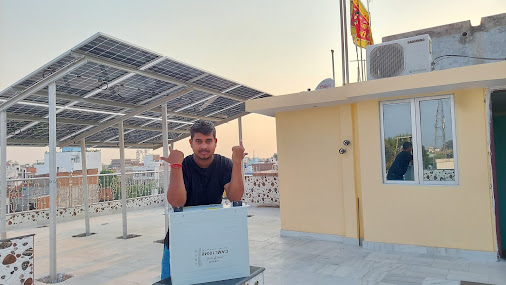Yes, you heard it right! One
of the prerequisites of an on grid solar installation is net metering. Net
meter or a bi-directional meter helps in calculating any excess power generated
from a customer’s solar system and being sold back to the grid for which the
customer gets a credit. However, recently there has been a lot of delay in
getting an on-grid system installed because of lack of adequate number of net
meters and problems in getting proper approvals and subsidies, which are the
major attractions behind installing an on-grid solar system.
Our recent efforts in
installing solar panels at hospitals left us with a realization that there are
many who are ready to go solar, but are held back due to the stress involved in
getting net meters and subsidies. There is a lot of paperwork and
bureaucracy involved in getting things done easily.
Solar Net Meter Technical
Feasibility
There are two criteria:
1.
The total solar PV capacity in the local distribution network (existing and
proposed) shall not exceed 30% of the
distribution transformer capacity. Example: A distribution network that
is served by a 250 KVA distribution transformer
cannot have more than 75 kW of total solar PV
capacity connected to it.
2.
The proposed solar PV system capacity cannot be more than the sanctioned or contacted load of the service
connection. If the proposed solar PV capacity is more than the service
connection sanctioned load, you first have to apply for service connection load
enhancement and then submit your solar net-metering application.
The Electricity Bill with
Solar net-metering
With solar net-metering the Consumer pays for the
difference between import and export energy (the net-metered energy). Example:
a Consumer imports during a billing cycle 900 kWh
(units) and exports 500 kWh. The
electricity bill will be for 400 kWh. If the
export energy exceeds the import energy, the excess of import kWh will be
carried over to the next billing cycle. During a 12 months period (the
Settlement Period - The period beginning from first of
April in an English calendar year and ending
with the thirty first of the
March of the next year) the maximum of energy export that will be credited by State
Generation and Distribution Corporation is 90% of
the energy import.
Example: During the settlement period there is a total
import of 5,000 kWh and a total export of 6,000 kWh. Of the 6,000 kWh exported 4,500
kWh is eligible for adjustment with the import kWh (90% of 5,000 kWh).
Solar Professional’s Overview
Let’s know from the solar enthusiasts…
Sneha Shah of Greenworldinvestor thinks that lack of easier options
to gain access to net meters and hassle free subsidies/ approvals is the need
of the hour. “Though the government has made various policies these are on
paper only and common man is suffering to gain access to resources such as net
meters”. She had recently published an article on her blog highlighting how
Delhi NCR is suffering from lack of adequate number of net meters. Vendors
confess having customers in hand but the situation is bad because of the
unavailability of net meters.
Mantosh Singh of Khalsa Electricals YouTuber and System Installer says
that I approved Net Meter within 30 days of 50 kW Solar System in Uttarakhand,
but residential homeowners approve Net Meter self. It will take time approx. 30
– 60 days.
मेरा नाम अनिकेत मिश्रा
है मैं यूपी के छोटे से जिले प्रतापगढ़ का निवासी हूँ । मैंने अपने घर के अत्यधिक
बिजली के बिल से परेशान होकर (जो कि गर्मी के दिनों में 3000 से 5000 प्रतिमाह के बीच आया करता है) बिल को कम करने के लिए अपने घर पर ऑनग्रिड सोलर रूफटॉप
सिस्टम लगवाने का विचार
किया जिसके लिए मेरे घर की छत पर पर्याप्त स्पेस, सूर्य का प्रकाश व दिन के समय विद्युत विभाग से लगभग निर्बाध बिजली की आपूर्ति, जो कि ऑनग्रिड सोलर PV
सिस्टम के लिए अतिआवश्यक
होती है, उपलब्ध थी । -
क्या
ऑनग्रिड सोलर सिस्टम के
लिए
नेटमीटरिंग लगवाना आवश्यक है
? यदि
किसी
कारण
से
विद्युत विभाग
से
नेटमीटर नही
मिल
पाता
है
तो
क्या
मैं
अपने
घर
पर
ऑन
ग्रिड
सोलर
सिस्टम नहीं
लगवा
सकूँगा ?
Similarly, our representative Nishi
Chandra says that he receives many queries on a daily basis regarding
challenges around on-grid solar installation…..
Today, customers are not very
keen on generating excess power and earning a discount on their power bills.
Instead, they want to generate enough electricity from their solar system and
be independent of the grid during the sunny hours. In the long run, a solar
system will anyways generate huge savings for its customer.
Solution to On Grid Solar System
Loom Solar, which is one of the leading solar companies with a huge
online presence in India has come up with an on-grid solution which will
function even without a net meter. Its 1 kW Solar AC module is capable
of generating enough power to comfortably run one air conditioner (up to 1.5
ton), along with refrigerator, TV, fans and lights during the day for a small
2-3 bhk house. You can read the full product detail here:
The advantage of using an AC
module is that it is more efficient than a DC module, has a longer
warranty and can function well even under shade or when installed on
a complicated roof. Solar Panel generates AC current and can be plugged
in any socket at home. People can generate huge saving while generating
free electricity.
Why should we opt Solar AC Module?
The advantage of using an AC module is that it is more efficient than a DC module, has a longer warranty and can function well even under shade or when installed on a complicated roof. Solar Panel generates AC current and can be plugged in any socket at home. People can generate huge saving while generating free electricity.
Why Should We Opt Solar AC Module?
·
Available Sizes in
340 Watt to 10 kW
·
Good for locations
with shade
·
Plug & play,
Safe and Easy to install: We assure
installation within 3 days
·
Net Metering is
Optional
·
Easy to expand:
Consumer can buy 1 Module, 2 module and easily expand when they want to buy.
·
Competitive Price:
Rs. 75,000 per kilowatt
FAQs
Here are few very common
questions that we receive frequently from our readers:
What is the mounting angle and
direction of installing solar panels?
Ans. The mounting angle
depends upon your latitude position and the season. It is generally 30 degrees.
The best direction to face solar panels is south, since India lies in Northern
Hemisphere. East and West directions also work well. North is the only
direction that we should not want to put our panels on.
Whether installation of
on-grid solar system will damage the roof?
Ans. No, installation of
on-grid solar system will not damage your roof.
If I get a solar system
installed, will the extra power be purchased by PSPCL?
Ans. Yes, extra power will be
purchased according to the feed-in tariff rates of the state provided you have
a net meter installed.
Is it possible to install a
solar system in Assam for residential purpose only?
Ans. Yes, you can read more
details on the Assam government portal.
I want solar panels installed
at my place. Can I have a visit by representatives?
Ans. Yes, our representatives
can pay you a visit and suggest you accordingly, depending upon your house
location, structure of the roof, electricity requirement etc.
Price of 3 kW solar system?
Ans. Off-grid will cost you
roughly Rs. 285,000 and on-grid solar system will cost Rs. 180,000.
We have 5 ACs of 2.5 ton each,
working round the clock for cold storage. Kindly suggest the size of on-grid
rooftop solar system.
Ans. A 2.5 ton AC generally
consumes in between 3000 watts per hour or 3 units
Total energy requirement daily
= 5*3*24 = 360 units
1 kW generates 3-4 units daily
(depending upon its location, efficiency etc.)
Size of solar system = 360/3 =
120 kW
How does the excess
electricity go back to the grid? Does government accept anywhere in cities?
Ans. The excess electricity
generated by a solar system goes back to the grid in the same way electricity
from the grid reaches our homes. This to and from movement of electricity is
recorded through net meter installed at the customer’s place. India has adopted
net metering in almost all its states.
What is the cost of 5 kW solar
system at office for day use only? Tell me the space required for installing
the system?
Ans. The cost of a 5 kW system
will be approximately Rs. 475,000 (for off-grid system) and Rs. 300,000
(on-grid system) and it needs … square meters area for installation.
I have a rooftop of 400 square
feet. I want to install 3 kW solar system. Can you guide me and send the cost?
Ans. Off-grid will cost you
roughly Rs. 285,000 and on-grid solar system will cost Rs. 180,000. 300 sq. ft.
area should be sufficient.
I have a 3 bhk flat. I would
like to install solar panels (on grid). Please suggest.
Ans. You need to specify your
power requirement in units or the appliances you use and the number of hours of
usage daily. Only then we will be able to better address your query.
Is it mandatory to have net
metering for an on-grid system?
If you want to claim a
discount in your power bill, only then net metering is mandatory. However, if
you are using the electricity for personal use only and not selling it back to
the grid, there is no requirement of net metering. Loom Solar has launched an
on-grid solar system which is capable of functioning even without net
metering.
Can we get subsidy only after
getting our solar system installed by installers listed on UPNEDA?
Ans. Yes, you can get subsidy
only after getting your solar system installed by installers listed on UPNEDA.
If we cannot get net metering
due to which our on-grid system could not be installed, how can we run the big
appliances like AC, submersible pumps at home?
Ans. You can install an
on-grid solar even without net metering and can run the heavy appliances by
installing Loom Solar’s newly launched Solar AC module. We have tested our
product and it is running successfully.
Source:
Grid Connected Solar Rooftop Systems:
snt.assam.gov.in/portlet-innerpage/grid-connected-solar-rooftop-systems














